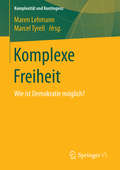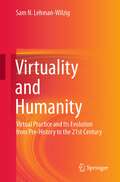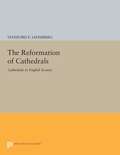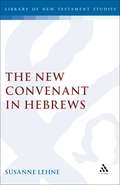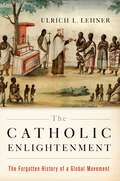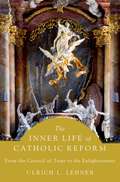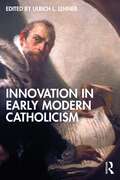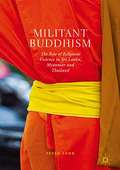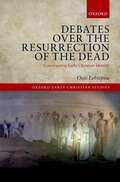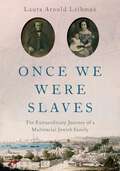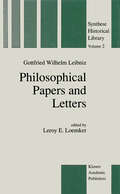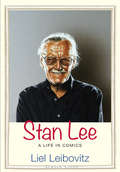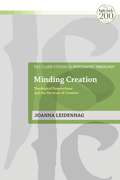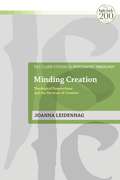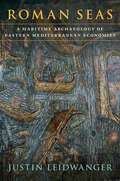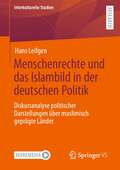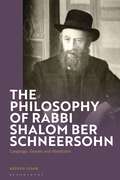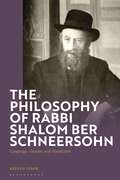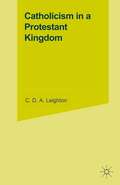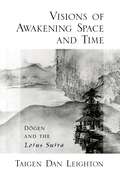- Table View
- List View
Komplexe Freiheit: Wie ist Demokratie möglich? (Komplexität und Kontingenz)
by Maren Lehmann Marcel TyrellDie ZU|Schriften bewegen sich im Rahmen der Unterscheidung von Komplexität und Kontingenz, um die Überlegung diskutieren zu können, dass jede soziale Umgebung ein vernetzter, komplexer Zusammenhang ist, der sich in ein verstehbares und bearbeitbares, orientierendes Format bringen und dabei die kontingente Selektivität dieses Formats mitreflektieren, sich also organisieren muss, um handlungsfähig zu sein und kritikfähig zu bleiben. Der vorliegende Band nimmt diese Überlegung als Frage nach der Möglichkeit ernst, Freiheit und Demokratie zu verbinden. Ist Demokratie eine Form komplexer Freiheit, das heißt vor allem: wird Freiheit durch Demokratie ermöglicht?Begriffsfragen bestimmen zunächst das Problem einer Freiheit genauer, die komplex ist, weil sie eingeschränkt ist, ohne festgelegt zu sein. Den Herausforderungen, die sich aus dieser spezifisch modernen Freiheitsform ergeben, gehen Verständigungsfragen und Machtfragen nach; sie suchen nach den Formen der Freiheit in demokratisch verfassten Ordnungen und sehen sich auch die politischen Risiken an, die durch ein Wechselspiel von Vereinfachung und Verkomplizierung in massenmedialen Öffentlichkeiten, rechtlichen Verfahren und hierarchischen Organisationen entstehen können. Kann die Komplexität der sozialen Welt so sehr anwachsen, dass Ordnungsbedürfnisse unbefriedigt bleiben? Kann die Kontingenz der sozialen Ordnung zu derart überfordernden Ungewissheiten und Unsicherheiten führen, dass nostalgische Blindheiten wie Zukunftsversprechen begrüßt werden?
Virtuality and Humanity: Virtual Practice and Its Evolution from Pre-History to the 21st Century
by Sam N. Lehman-WilzigThis is a pioneering study of virtuality through human history: ancient-to-modern evolution and recent expansion; expression in many fields (chapters on Religion; Philosophy, Math, Physics; Literature and the Arts; Economics; Nationhood, Government and War; Communication); psychological and social reasons for its universality; inter-relationship with "reality." The book's thesis: virtuality was always an integral part of humanity in many areas of life, generally expanding over the ages. The reasons: 1- brain psychology; 2- virtuality's six functions — escape from boredom to relieving existential dread. Other questions addressed: How will future neuroscience, biotech and "compunications" affect virtuality? Can/should there be limits to human virtualizing?
The Reformation of Cathedrals: Cathedrals in English Society
by Stanford E. LehmbergStanford Lehmberg, a noted authority on the Tudor period, examines the impact of the Reformation on the cathedrals of England and Wales. Based largely on manuscript materials from the cathedral archives themselves, this book is the first attempt to draw together information for all twenty-nine of the cathedrals that existed in the Tudor period. The author scrutinizes the major changes that took place during this era in the institutional structure, personnel, endowments, liturgy, and music of the cathedral and shows how the cathedrals, unlike the monasteries that were dissolved by Henry VIII, succeeded in adapting successfully to the Reformation. Forty-two illustrations depict sixteenth-century changes in cathedral buildings.Narrative chapters trace the changes that occurred during the reigns of Henry VIII, Edward VI, "Bloody" Mary, and Elizabeth I. Analytical sections are devoted to cathedral finance and cathedral music. The changing lives of cathedral musicians are described in some detail, and even greater attention is paid to the cathedral clergy, whose living conditions changed markedly when they were allowed to marry. Using a variety of sources, including such physical remains as tombs and monuments, the concluding chapter discusses the role of cathedrals in English society.Originally published in 1989.The Princeton Legacy Library uses the latest print-on-demand technology to again make available previously out-of-print books from the distinguished backlist of Princeton University Press. These editions preserve the original texts of these important books while presenting them in durable paperback and hardcover editions. The goal of the Princeton Legacy Library is to vastly increase access to the rich scholarly heritage found in the thousands of books published by Princeton University Press since its founding in 1905.
The New Covenant in Hebrews (The Library of New Testament Studies #44)
by Susanne LehneIn Hebrews the New Covenant concept is the key to the author's hermeneutical scheme. When the New Covenant in Hebrews is compared with the same idea in the Dead Sea Scrolls, in Paul and in the Last Supper accounts, the independence and originality of the author of Hebrews become evident. His cultic reinterpretation of the New Covenant concept allows him to depict the Christ event in continuity with its Levitical heritage, through the shared rubrics of high priest, bloody sacrifice and tent. His simultaneous stress on the new, heavenly character of the New Covenant is designed to convince his readers of its surpassing effectiveness and definitive superiority.
The Catholic Enlightenment: The Forgotten History of a Global Movement
by Ulrich L. Lehner"Whoever needs an act of faith to elucidate an event that can be explained by reason is a fool, and unworthy of reasonable thought." This line, spoken by the notorious 18th-century libertine Giacomo Casanova, illustrates a deeply entrenched perception of religion, as prevalent today as it was hundreds of years ago. It is the sentiment behind the narrative that Catholic beliefs were incompatible with the Enlightenment ideals. Catholics, many claim, are superstitious and traditional, opposed to democracy and gender equality, and hostile to science. It may come as a surprise, then, to learn that Casanova himself was a Catholic. In The Catholic Enlightenment, Ulrich L. Lehner points to such figures as representatives of a long-overlooked thread of a reform-minded Catholicism, which engaged Enlightenment ideals with as much fervor and intellectual gravity as anyone. Their story opens new pathways for understanding how faith and modernity can interact in our own time. Lehner begins two hundred years before the Enlightenment, when the Protestant Reformation destroyed the hegemony Catholicism had enjoyed for centuries. During this time the Catholic Church instituted several reforms, such as better education for pastors, more liberal ideas about the roles of women, and an emphasis on human freedom as a critical feature of theology. These actions formed the foundation of the Enlightenment's belief in individual freedom. While giants like Spinoza, Locke, and Voltaire became some of the most influential voices of the time, Catholic Enlighteners were right alongside them. They denounced fanaticism, superstition, and prejudice as irreconcilable with the Enlightenment agenda. In 1789, the French Revolution dealt a devastating blow to their cause, disillusioning many Catholics against the idea of modernization. Popes accumulated ever more power and the Catholic Enlightenment was snuffed out. It was not until the Second Vatican Council in 1962 that questions of Catholicism's compatibility with modernity would be broached again. Ulrich L. Lehner tells, for the first time, the forgotten story of these reform-minded Catholics. As Pope Francis pushes the boundaries of Catholicism even further, and Catholics once again grapple with these questions, this book will prove to be required reading.
The Catholic Enlightenment: The Forgotten History of a Global Movement
by Ulrich L. Lehner"Whoever needs an act of faith to elucidate an event that can be explained by reason is a fool, and unworthy of reasonable thought." This line, spoken by the notorious 18th-century libertine Giacomo Casanova, illustrates a deeply entrenched perception of religion, as prevalent today as it was hundreds of years ago. It is the sentiment behind the narrative that Catholic beliefs were incompatible with the Enlightenment ideals. Catholics, many claim, are superstitious and traditional, opposed to democracy and gender equality, and hostile to science. It may come as a surprise, then, to learn that Casanova himself was a Catholic. In The Catholic Enlightenment, Ulrich L. Lehner points to such figures as representatives of a long-overlooked thread of a reform-minded Catholicism, which engaged Enlightenment ideals with as much fervor and intellectual gravity as anyone. Their story opens new pathways for understanding how faith and modernity can interact in our own time. Lehner begins two hundred years before the Enlightenment, when the Protestant Reformation destroyed the hegemony Catholicism had enjoyed for centuries. During this time the Catholic Church instituted several reforms, such as better education for pastors, more liberal ideas about the roles of women, and an emphasis on human freedom as a critical feature of theology. These actions formed the foundation of the Enlightenment's belief in individual freedom. While giants like Spinoza, Locke, and Voltaire became some of the most influential voices of the time, Catholic Enlighteners were right alongside them. They denounced fanaticism, superstition, and prejudice as irreconcilable with the Enlightenment agenda. In 1789, the French Revolution dealt a devastating blow to their cause, disillusioning many Catholics against the idea of modernization. Popes accumulated ever more power and the Catholic Enlightenment was snuffed out. It was not until the Second Vatican Council in 1962 that questions of Catholicism's compatibility with modernity would be broached again. Ulrich L. Lehner tells, for the first time, the forgotten story of these reform-minded Catholics. As Pope Francis pushes the boundaries of Catholicism even further, and Catholics once again grapple with these questions, this book will prove to be required reading.
The Inner Life of Catholic Reform: From the Council of Trent to the Enlightenment
by Ulrich L. LehnerIn The Inner Life of Catholic Reform, Ulrich Lehner offers a longue durée overview of the sentiments and spiritual ideas of the 250-year long time span following the Council of Trent, known as Catholic Reform. While there have been many studies of the so-called Counter-Reformation, the political side of Catholic Reform, and of its institutional and social history, the sentiments, motivations and religious practices of Catholic Reform--what Lehner calls the "inner life"--have been mostly neglected. Reform, Lehner argues, was not something that occurred merely through institutional changes, new laws, and social control. For early modern Catholics, church reform began with personal reform and attempts to live in a state of grace. Lehner seeks to take these religious commitments seriously and understand them on their own terms. The central question he asks is "What did Catholics do to obtain salvation, to make themselves pleasing to God?" Lehner examines how the spiritual ideas that emerged from attempts to wrestle with the question of the salvation of souls changed the Catholic view of the world. Drawing on a plethora of published and unpublished sources and a wide array of secondary literature--with an emphasis on Europe, but integrating material from Africa, America, and Asia--Lehner documents this transformative period in history, when Catholicism became a "world religion."
The Inner Life of Catholic Reform: From the Council of Trent to the Enlightenment
by Ulrich L. LehnerIn The Inner Life of Catholic Reform, Ulrich Lehner offers a longue durée overview of the sentiments and spiritual ideas of the 250-year long time span following the Council of Trent, known as Catholic Reform. While there have been many studies of the so-called Counter-Reformation, the political side of Catholic Reform, and of its institutional and social history, the sentiments, motivations and religious practices of Catholic Reform--what Lehner calls the "inner life"--have been mostly neglected. Reform, Lehner argues, was not something that occurred merely through institutional changes, new laws, and social control. For early modern Catholics, church reform began with personal reform and attempts to live in a state of grace. Lehner seeks to take these religious commitments seriously and understand them on their own terms. The central question he asks is "What did Catholics do to obtain salvation, to make themselves pleasing to God?" Lehner examines how the spiritual ideas that emerged from attempts to wrestle with the question of the salvation of souls changed the Catholic view of the world. Drawing on a plethora of published and unpublished sources and a wide array of secondary literature--with an emphasis on Europe, but integrating material from Africa, America, and Asia--Lehner documents this transformative period in history, when Catholicism became a "world religion."
Innovation in Early Modern Catholicism
by Ulrich L. LehnerThis volume demonstrates that the Catholic rhetoric of tradition disguised both novelties and creative innovations between 1550 and 1700. Innovation in Early Modern Catholicism reveals that the period between 1550 and 1700 emerged as an intellectually vibrant atmosphere, shaped by the tensions between personal creativity and magisterial authority. The essays explore ideas about grace, physical predetermination, freedom, and probabilism in order to show how the rhetoric of innovation and tradition can be better understood. More importantly, contributors illustrate how disintegrated historiographies, which often excluded Catholicism as a source of innovation, can be overcome. Not only were new systems of metaphysics crafted in the early modern period, but so too was a new conceptual language to deal with the pressing problems of human freedom and grace, natural law, and Marian piety. Overall, the volume shines significant light on hitherto neglected or misunderstood traits in the understanding of early modern Catholic culture. Re-presenting early modern Catholicism more crucially than any other currently available study, Innovation in Early Modern Catholicism is a useful tool for advanced undergraduates, postgraduates, and scholars in the fields of philosophy, early modern studies, and the history of theology.
Innovation in Early Modern Catholicism
by Ulrich L. LehnerThis volume demonstrates that the Catholic rhetoric of tradition disguised both novelties and creative innovations between 1550 and 1700. Innovation in Early Modern Catholicism reveals that the period between 1550 and 1700 emerged as an intellectually vibrant atmosphere, shaped by the tensions between personal creativity and magisterial authority. The essays explore ideas about grace, physical predetermination, freedom, and probabilism in order to show how the rhetoric of innovation and tradition can be better understood. More importantly, contributors illustrate how disintegrated historiographies, which often excluded Catholicism as a source of innovation, can be overcome. Not only were new systems of metaphysics crafted in the early modern period, but so too was a new conceptual language to deal with the pressing problems of human freedom and grace, natural law, and Marian piety. Overall, the volume shines significant light on hitherto neglected or misunderstood traits in the understanding of early modern Catholic culture. Re-presenting early modern Catholicism more crucially than any other currently available study, Innovation in Early Modern Catholicism is a useful tool for advanced undergraduates, postgraduates, and scholars in the fields of philosophy, early modern studies, and the history of theology.
Militant Buddhism: The Rise of Religious Violence in Sri Lanka, Myanmar and Thailand
by Peter LehrAgainst the backdrop of the ongoing Rohingya crisis, this book takes a close and detailed look at the rise of militant Buddhism in Sri Lanka, Burma and Thailand, and especially at the issues of ‘why’ and ‘how’ around it. We are well aware of Christian fundamentalism, militant Judaism and Islamist Salafism-Jihadism. Extremist and violent Buddhism however features only rarely in book-length studies on religion and political violence. Somehow, the very idea of Buddhist monks as the archetypical ‘world renouncers’ exhorting frenzied mobs to commit acts of violence against perceived ‘enemies of the religion’ seems to be outright ludicrous. Recent events in Myanmar/Burma, but also in Thailand and Sri Lanka, however indicate that a militant strand of Theravada Buddhism is on the rise. How can this rise be explained, and what role do monks play in that regard? These are the two broad questions that this book explores.
Debates over the Resurrection of the Dead: Constructing Early Christian Identity (Oxford Early Christian Studies)
by Outi LehtipuuIn Debates over the Resurrection of the Dead, Outi Lehtipuu highlights the striking observation that in many early texts the way that belief in resurrection is formulated is used as a sign of inclusion and exclusion, not only in relation to non-Christians but vis-à-vis other Christians. Those who teach otherwise have deviated from the truth, are not true Christians, and do the works of the devil. Using insights from the sociological study of deviance, Dr Lehtipuu demonstrates that labelling was used as a tool for marking boundaries between those who belonged and those who did not. This was extremely important in the fluid conditions where the small Christian minority groups found themselves. In a situation where there were no universally accepted structures that defined what constituted the true Christian belief, several competing interpretations and their representatives struggled for recognition of their views based on what they believed to be the apostolic tradition. The most hotly-debated aspect of resurrection was whether it would entail the body of flesh and blood or not. When resurrection would take place was closely related to this. Controversies died since the scriptural legacy was ambiguous enough to allow different hermeneutical solutions. The battle over resurrection was closely related to the question of how scriptures were to be understood as well as to what constituted the human self that would survive death. To demonstrate this a wide variety of texts are studied, from theological treatises (including relevant Nag Hammadi texts) to apocryphal acts and martyrologies. Acknowledging the complexity and diversity of the early Christian movement, this volume views early Christian discourse as part of the broader ancient discursive world where similar debates were going on among both Jews and the majority population.
Once We Were Slaves: The Extraordinary Journey of a Multi-Racial Jewish Family
by Laura Arnold LeibmanAn obsessive genealogist and descendent of one of the most prominent Jewish families since the American Revolution, Blanche Moses firmly believed her maternal ancestors were Sephardic grandees. Yet she found herself at a dead end when it came to her grandmother's maternal line. Using family heirlooms to unlock the mystery of Moses's ancestors, Once We Were Slaves overturns the reclusive heiress's assumptions about her family history to reveal that her grandmother and great-uncle, Sarah and Isaac Brandon, actually began their lives as poor Christian slaves in Barbados. Tracing the siblings' extraordinary journey throughout the Atlantic World, Leibman examines artifacts they left behind in Barbados, Suriname, London, Philadelphia, and, finally, New York, to show how Sarah and Isaac were able to transform themselves and their lives, becoming free, wealthy, Jewish, and--at times--white. While their affluence made them unusual, their story mirrors that of the largely forgotten population of mixed African and Jewish ancestry that constituted as much as ten percent of the Jewish communities in which the siblings lived, and sheds new light on the fluidity of race--as well as on the role of religion in racial shift--in the first half of the nineteenth century.
Once We Were Slaves: The Extraordinary Journey of a Multi-Racial Jewish Family
by Laura Arnold LeibmanAn obsessive genealogist and descendent of one of the most prominent Jewish families since the American Revolution, Blanche Moses firmly believed her maternal ancestors were Sephardic grandees. Yet she found herself at a dead end when it came to her grandmother's maternal line. Using family heirlooms to unlock the mystery of Moses's ancestors, Once We Were Slaves overturns the reclusive heiress's assumptions about her family history to reveal that her grandmother and great-uncle, Sarah and Isaac Brandon, actually began their lives as poor Christian slaves in Barbados. Tracing the siblings' extraordinary journey throughout the Atlantic World, Leibman examines artifacts they left behind in Barbados, Suriname, London, Philadelphia, and, finally, New York, to show how Sarah and Isaac were able to transform themselves and their lives, becoming free, wealthy, Jewish, and--at times--white. While their affluence made them unusual, their story mirrors that of the largely forgotten population of mixed African and Jewish ancestry that constituted as much as ten percent of the Jewish communities in which the siblings lived, and sheds new light on the fluidity of race--as well as on the role of religion in racial shift--in the first half of the nineteenth century.
Philosophical Papers and Letters: A Selection (Synthese Historical Library #2)
by G.W. LeibnizThe selections contained in these volumes from the papers and letters of Leibniz are intended to serve the student in two ways: first, by providing a more adequate and balanced conception of the full range and penetration of Leibniz's creative intellectual powers; second, by inviting a fresher approach to his intellectual growth and a clearer perception of the internal strains in his thinking, through a chronological arrangement. Much confusion has arisen in the past through a neglect of the develop ment of Leibniz's ideas, and Couturat's impressive plea, in his edition of the Opuscu/es et fragments (p. xii), for such an arrangement is valid even for incomplete editions. The beginning student will do well, however, to read the maturer writings of Parts II, III, and IV first, leaving Part I, from a period too largely neglected by Leibniz criticism, for a later study of the still obscure sources and motives of his thought. The Introduction aims primarily to provide cultural orientation and an exposition of the structure and the underlying assumptions of the philosophical system rather than a critical evaluation. I hope that together with the notes and the Index, it will provide those aids to the understanding which the originality of Leibniz's scientific, ethical, and metaphysical efforts deserve.
Stan Lee: A Life in Comics (Jewish Lives)
by Liel LeibovitzFrom the prizewinning Jewish Lives series, a meditation on the deeply Jewish and surprisingly spiritual roots of Stan Lee and Marvel Comics Few artists have had as much of an impact on American popular culture as Stan Lee. The characters he created—Spider-Man and Iron Man, the X-Men and the Fantastic Four—occupy Hollywood’s imagination and production schedules, generate billions at the box office, and come as close as anything we have to a shared American mythology. This illuminating biography focuses as much on Lee’s ideas as it does on his unlikely rise to stardom. It surveys his cultural and religious upbringing and draws surprising connections between celebrated comic book heroes and the ancient tales of the Bible, the Talmud, and Jewish mysticism. Was Spider-Man just a reincarnation of Cain? Is the Incredible Hulk simply Adam by another name? From close readings of Lee’s work to little-known anecdotes from Marvel’s history, the book paints a portrait of Lee that goes much deeper than one of his signature onscreen cameos.About Jewish Lives: Jewish Lives is a prizewinning series of interpretative biography designed to explore the many facets of Jewish identity. Individual volumes illuminate the imprint of Jewish figures upon literature, religion, philosophy, politics, cultural and economic life, and the arts and sciences. Subjects are paired with authors to elicit lively, deeply informed books that explore the range and depth of the Jewish experience from antiquity to the present. In 2014, the Jewish Book Council named Jewish Lives the winner of its Jewish Book of the Year Award, the first series ever to receive this award.More praise for Jewish Lives: "Excellent." – New York times "Exemplary." – Wall St. Journal "Distinguished." – New Yorker "Superb." – The Guardian
Minding Creation: Theological Panpsychism And The Doctrine Of Creation (T&T Clark Studies in Systematic Theology)
by Joanna LeidenhagAre humans the only creatures that can appreciate God's creation? What if consciousness is spread more widely across all things? This volume examines panpsychism through the lens of Christian doctrine. Minding Creation is the first substantial examination of what a panpsychist theory of consciousness implies for key theological debates concerning God's presence and action, evolution and the origin of the soul, human uniqueness and the environmental crisis.Joanna Leidenhag develops a theological panpsychism that is based on an exceptionally wide range of scholarship. Minding Creation draws on the theologies of historical figures such as Augustine of Hippo, Gottfried von Leibniz and others, in order to create a critical and constructive conversation with contemporary analytic philosophers of mind, such as Thomas Nagel, Galen Strawson, and David J. Chalmers. Leidenhag also discusses key concepts and issues, such as emergence theory, divine action, and ecology. She concludes that God created a universe from nothing which is filled with indwelling powers, sacramental value, and intrinsic experience. This is a creation in which the Holy Spirit is internally present at every point, a creation that worships God, and a creation that human beings must protect and lead in praise.
Minding Creation: Theological Panpsychism and the Doctrine of Creation (T&T Clark Studies in Systematic Theology)
by Joanna LeidenhagAre humans the only creatures that can appreciate God's creation? What if consciousness is spread more widely across all things? This volume examines panpsychism through the lens of Christian doctrine. Minding Creation is the first substantial examination of what a panpsychist theory of consciousness implies for key theological debates concerning God's presence and action, evolution and the origin of the soul, human uniqueness and the environmental crisis.Joanna Leidenhag develops a theological panpsychism that is based on an exceptionally wide range of scholarship. Minding Creation draws on the theologies of historical figures such as Augustine of Hippo, Gottfried von Leibniz and others, in order to create a critical and constructive conversation with contemporary analytic philosophers of mind, such as Thomas Nagel, Galen Strawson, and David J. Chalmers. Leidenhag also discusses key concepts and issues, such as emergence theory, divine action, and ecology. She concludes that God created a universe from nothing which is filled with indwelling powers, sacramental value, and intrinsic experience. This is a creation in which the Holy Spirit is internally present at every point, a creation that worships God, and a creation that human beings must protect and lead in praise.
Roman Seas: A Maritime Archaeology of Eastern Mediterranean Economies
by Justin LeidwangerThat seafaring was fundamental to Roman prosperity in the eastern Mediterranean is beyond doubt, but a tendency by scholars to focus on the grandest long-distance movements between major cities has obscured the finer and varied contours of maritime interaction. This book offers a nuanced archaeological analysis of maritime economy and connectivity in the Roman east. Drawing together maritime landscape studies and network analysis, Roman Seas takes a bottom-up view of the diverse socioeconomic conditions and seafaring logistics that generated multiple structures and scales of interaction. The material record of shipwrecks and ports along a vital corridor from the southeast Aegean across the northeast Mediterranean provides a case study of regional exchange and communication based on routine sails between simple coastal harbors. Rather than a single well-integrated and persistent Mediterranean network, multiple discrete and evolving regional and interregional systems emerge. This analysis sheds light on the cadence of economic life along the coast, the development of market institutions, and the regional continuities that underpinned integration-despite imperial fragmentation-between the second century BCE and the seventh century CE. Roman Seas advances a new approach to the synthesis of shipwreck and other maritime archaeological and historical economic data, as well as a path through the stark dichotomies-either big commercial voyages or small-scale cabotage-that inform most paradigms of Roman connectivity and trade. The result is a unique perspective on ancient Mediterranean trade, seafaring, cultural interaction, and coastal life.
Roman Seas: A Maritime Archaeology of Eastern Mediterranean Economies
by Justin LeidwangerThat seafaring was fundamental to Roman prosperity in the eastern Mediterranean is beyond doubt, but a tendency by scholars to focus on the grandest long-distance movements between major cities has obscured the finer and varied contours of maritime interaction. This book offers a nuanced archaeological analysis of maritime economy and connectivity in the Roman east. Drawing together maritime landscape studies and network analysis, Roman Seas takes a bottom-up view of the diverse socioeconomic conditions and seafaring logistics that generated multiple structures and scales of interaction. The material record of shipwrecks and ports along a vital corridor from the southeast Aegean across the northeast Mediterranean provides a case study of regional exchange and communication based on routine sails between simple coastal harbors. Rather than a single well-integrated and persistent Mediterranean network, multiple discrete and evolving regional and interregional systems emerge. This analysis sheds light on the cadence of economic life along the coast, the development of market institutions, and the regional continuities that underpinned integration-despite imperial fragmentation-between the second century BCE and the seventh century CE. Roman Seas advances a new approach to the synthesis of shipwreck and other maritime archaeological and historical economic data, as well as a path through the stark dichotomies-either big commercial voyages or small-scale cabotage-that inform most paradigms of Roman connectivity and trade. The result is a unique perspective on ancient Mediterranean trade, seafaring, cultural interaction, and coastal life.
Menschenrechte und das Islambild in der deutschen Politik: Diskursanalyse politischer Darstellungen über muslimisch geprägte Länder (Interkulturelle Studien)
by Hans LeifgenPolitische Berichte und menschenrechtliche Debatten prägen das Islambild in Deutschland mit. Die vorliegende Forschungsarbeit setzt sich exemplarisch mit der Menschenrechtsberichterstattung der politischen Fraktionen im Deutschen Bundestag über muslimisch geprägte Länder auseinander. Im Zentrum des Interesses stehen dabei die Fragen, wie die Menschenrechtslage in muslimisch geprägten Ländern dargestellt und welcher menschenrechtliche Bezugsrahmen verwendet wird sowie, welche Rolle die Religion Islam bei der Berichterstattung spielt. Hierzu werden die diskurstheoretische Perspektive Foucaults (1981) und der forschungsmethodische Zugang der Kritischen Diskursanalyse Jägers (2015) herangezogen. Ziel der Forschung ist, exemplarische Erkenntnisse über potenzielle gesamtgesellschaftliche Auswirkungen der Berichterstattung – insbesondere auf das Islambild in Deutschland – zu erhalten. Daher untersucht die Arbeit, wie bei der Berichterstattung Wirklichkeit konstruiert wird.
The Philosophy of Rabbi Shalom Ber Schneersohn: Language, Gender and Mysticism
by Rabbi Dr Reuven LeighReuven Leigh provides the first in-depth introduction to the pioneering philosophy of Rabbi Shalom Ber Schneersohn. Bringing him into dialogue with key continental philosophers Emmanuel Levinas, Jacques Derrida and Julia Kristeva, this book reveals how Schneersohn's views anticipated many prominent themes in 20th-century thought. Shalom Ber Schneersohn (1860-1920) was the fifth Rebbe of the Habad-Lubavitch dynasty. He was a traditional, kabbalistic thinker and yet, beyond mysticism, he wrote extensively on speech, gender and the body. So why is he not better known? Leigh begins by uncovering and contesting numerous scholarly assumptions that have operated to exclude traditional rabbinic thinkers from contemporary philosophical debates. Seeking to correct this, this book offers a close reading of Schneersohn's 1898 discourses. With the disruption of traditional binary structures being the dominant theme pervading Schneersohn's work, Leigh engages with Levinas' provocative ideas on speech and the feminine. He also highlights how Derridean deconstruction involves a more positive approach to presence that was already anticipated in the writings of Schneersohn. And from the disruption of the hierarchy of signification to the semiotic aspect of language and the maternal body, this book demonstrates how Schneersohn foreshadows a number of Kristeva's central philosophical concerns. A wide-ranging and inclusive volume, The Philosophy of Rabbi Shalom Ber Schneersohn demonstrates not only how forward-thinking Schneersohn's ideas were over a century ago, but how relevant they still are today.
The Philosophy of Rabbi Shalom Ber Schneersohn: Language, Gender and Mysticism
by Rabbi Dr Reuven LeighReuven Leigh provides the first in-depth introduction to the pioneering philosophy of Rabbi Shalom Ber Schneersohn. Bringing him into dialogue with key continental philosophers Emmanuel Levinas, Jacques Derrida and Julia Kristeva, this book reveals how Schneersohn's views anticipated many prominent themes in 20th-century thought. Shalom Ber Schneersohn (1860-1920) was the fifth Rebbe of the Habad-Lubavitch dynasty. He was a traditional, kabbalistic thinker and yet, beyond mysticism, he wrote extensively on speech, gender and the body. So why is he not better known? Leigh begins by uncovering and contesting numerous scholarly assumptions that have operated to exclude traditional rabbinic thinkers from contemporary philosophical debates. Seeking to correct this, this book offers a close reading of Schneersohn's 1898 discourses. With the disruption of traditional binary structures being the dominant theme pervading Schneersohn's work, Leigh engages with Levinas' provocative ideas on speech and the feminine. He also highlights how Derridean deconstruction involves a more positive approach to presence that was already anticipated in the writings of Schneersohn. And from the disruption of the hierarchy of signification to the semiotic aspect of language and the maternal body, this book demonstrates how Schneersohn foreshadows a number of Kristeva's central philosophical concerns. A wide-ranging and inclusive volume, The Philosophy of Rabbi Shalom Ber Schneersohn demonstrates not only how forward-thinking Schneersohn's ideas were over a century ago, but how relevant they still are today.
Catholicism in a Protestant Kingdom: A Study of the Irish Ancien Régime (Studies in Modern History)
by C.D.A. LeightonEscaping from narrative history, this book takes a deep look at the Catholic question in eighteenth-century Ireland. It asks how people thought about Catholicism, Protestantism and their society, in order to reassess the content and importance of the religious conflict. In doing this, Dr Cadoc Leighton provides a study of very wide appeal, which offers new and thought-provoking ways of looking not only at the eighteenth century but at modern Irish history in general. It also places Ireland clearly within the mainstream of European historical developments.
Visions of Awakening Space and Time: Dōgen and the Lotus Sutra
by Taigen Dan LeightonAs a religion concerned with universal liberation, Zen grew out of a Buddhist worldview very different from the currently prevalent scientific materialism. Indeed, says Taigen Dan Leighton, Zen cannot be fully understood outside of a worldview that sees reality itself as a vital, dynamic agent of awareness and healing. In this book, Leighton explicates that worldview through the writings of the Zen master Eihei Dōgen (1200-1253), considered the founder of the Japanese Sōtō Zen tradition, which currently enjoys increasing popularity in the West. The Lotus Sutra, arguably the most important Buddhist scripture in East Asia, contains a famous story about bodhisattvas (enlightening beings) who emerge from under the earth to preserve and expound the Lotus teaching in the distant future. The story reveals that the Buddha only appears to pass away, but actually has been practicing, and will continue to do so, over an inconceivably long life span. Leighton traces commentaries on the Lotus Sutra from a range of key East Asian Buddhist thinkers, including Daosheng, Zhiyi, Zhanran, Saigyo, Myōe, Nichiren, Hakuin, and Ryōkan. But his main focus is Eihei Dōgen, the 13th century Japanese Sōtō Zen founder who imported Zen from China, and whose profuse, provocative, and poetic writings are important to the modern expansion of Buddhism to the West. Dōgen's use of this sutra expresses the critical role of Mahayana vision and imagination as the context of Zen teaching, and his interpretations of this story furthermore reveal his dynamic worldview of the earth, space, and time themselves as vital agents of spiritual awakening. Leighton argues that Dōgen uses the images and metaphors in this story to express his own religious worldview, in which earth, space, and time are lively agents in the bodhisattva project. Broader awareness of Dōgen's worldview and its implications, says Leighton, can illuminate the possibilities for contemporary approaches to primary Mahayana concepts and practices.
